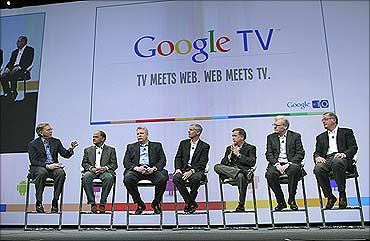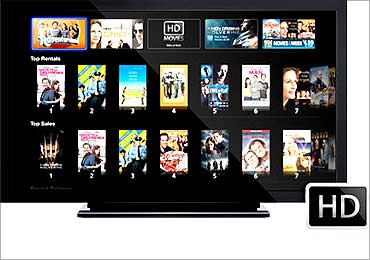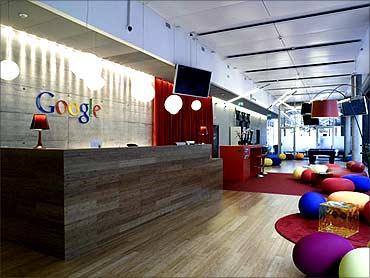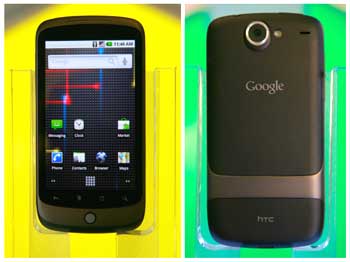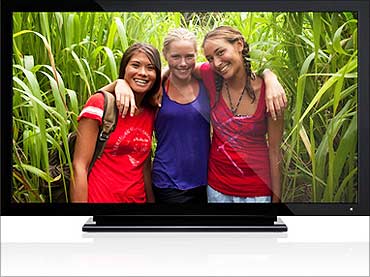 | « Back to article | Print this article |
Will Google TV become a success?
If you're visiting the US around September this year, your TV may not only show channels but also allow you to surf websites, watch videos or listen to music.
Google, the online search giant, has made this possible by launching Google TV a couple of days back at its developer 'I/O' event in San Francisco.
Google is working with Sony and Logitech to put Google TV (Google search built into the TV to pull web video and broadcast) inside TVs, Blu-ray players and companion boxes.
Click on NEXT to read more...
Will Google TV become a success?
These devices will go on sale around September 2010, and will be available at Best Buy stores in the US initially. Google is expected to launch it internationally in 2011.
"With the web, finding and accessing interesting content is fast and often as easy as a search. But the web still lacks many of the great features and the high-quality viewing experience that TV offers. So that got us thinking...what if we helped people experience the best of TV and the best of the web in one seamless experience?" reasons Google on its official blog site.
Google TV follows the not-so-successful forays of Apple and Microsoft to bring the internet to TV with Apple TV and MSN TV. Google, however, believes there is a huge market opportunity in this space with around 4 billion people across the world watching TV.
Click on NEXT to read more...
Will Google TV become a success?
The browser on Google TV is simply the Linux version of Google Chrome. The user interface will have to be modified for TV, else how will a website designed for a smaller monitor turn into a larger one? And the same software that powers Google's mobile devices - Android - is being used to power Google TV.
With the browser built in, Google TV is expected to help you access all of your favourite websites and easily move between TV and the web. Your TV, hence, becomes more than a TV - it can be a photo slideshow viewer, a gaming console, a music player and much more.
Click on NEXT to read more...
Will Google TV become a success?
Google TV uses search to give an easy and fast way to navigate to TV channels, websites, apps, shows and movies. For example, if you already know the channel or programme you want to watch, you need to just type in the name and you're there.
If you want to check out a YouTube video, that too will be just a quick search away. If you know what you want to watch, but you're not sure where to find it, you can simply type in what you're looking for and Google TV will help you find it on the web or on one of your many TV channels.
If you'd rather browse than search, you can use your standard programme guide, your DVR or the Google TV home screen.
Click on NEXT to read more...
Will Google TV become a success?
Google has started building strategic alliances with a number of companies like Jinni.com and Rovi. Jinni.com is a next-generation TV application firm working to provide semantic search, personalised recommendation and social features for Google TV across all sources of premium content available to the user. Rovi is one of the world's leading guide applications.
Because Google TV is built on open platforms like Android and Google Chrome, these features are just a fraction of what Google TV can do, notes the Google blog.
"In our announcement at Google I/O, we challenged web developers to start coming up with the next great web and Android apps designed specifically for the TV experience. Developers can start optimising their websites...," notes the official Google blog.
Click on NEXT to read more...
Will Google TV become a success?
The space is very competitive, they point out. For instance, Samsung, LG and Panasonic outsell Sony (Google TV's partner) in the LCD TV space and they all have their own internet protocol TV (IPTV) solutions and partners.
LG partnered with DivX earlier this year to bring DivX TV to its Blu-ray players. Samsung and Yahoo have partnered with internet (Internet)@TV, and Panasonic has its Viera Cast system.
Other analysts note that with the exception of the stand-alone web browser, Google TV is similar to the latest version of TiVo. Features like viewing photos, streaming music and searching for upcoming programming were possible on TiVo way back in 2003. Moreover, one could view content from Amazon Video-On Demand, YouTube and Netflix even in 2007.
Then there are competing set-top box products like Boxee, PopBox and Roku. Boxee, for instance, has established a base of users via its computer and Apple TV platform. Boxee doesn't integrate into the live TV experience like Google TV, but it supports third-party apps, can do regular web browsing and also seamlessly links to existing media libraries.
Click on NEXT to read more...
Will Google TV become a success?
Incidentally, both Apple and Microsoft failed in their efforts to make the connected TV space a roaring success. Apple continues to sell the Apple TV product but in small numbers. And the original WebTV was purchased by Microsoft and rebranded as MSN TV.
Microsoft continues to support existing customers, but no longer sells the hardware. These are early days, and it remains to be seen how Google TV tackles the web-TV integration space.
Click on NEXT to read more...
